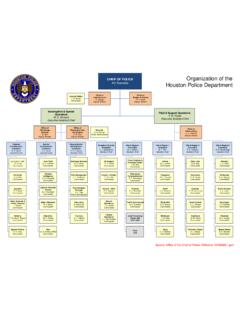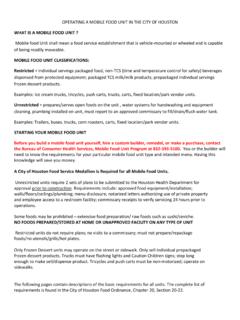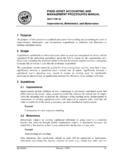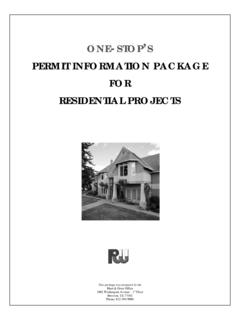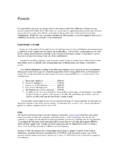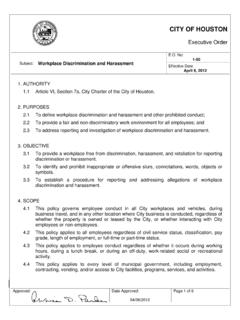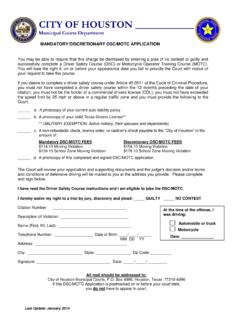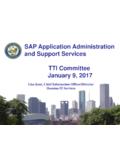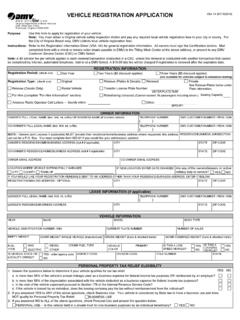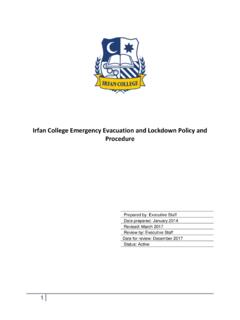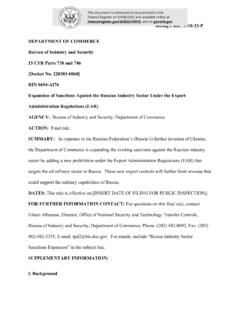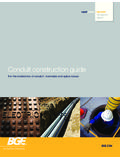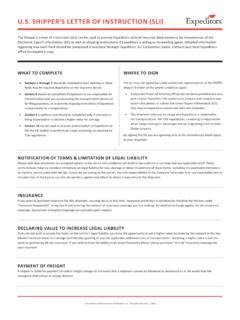Transcription of Landscape Regulations for Development - Houston
1 Landscape Regulations for Development Tree and Shrub Ordinance The City of Houston Tree and Shrub Ordinance provides standards for planting trees and shrubs and installing landscaping buffers. The ordinance further protects Houston 's greenery by prohibiting removal of certain trees and offering incentives to property owners who preserve and care for existing trees on private properties. Based on a property's size, the ordinance establishes minimum planting requirements for street trees, parking lot trees, and shrubs. These minimum requirements ensure that Houston will have aesthetically pleasing developments and enhanced greenspace, making it a better place to live. The ordinance's planting requirements apply to all new commercial and multi-family residential developments that require a building permit or any property expansion exceeding 1,000 square feet. The ordinance also applies to all new single family construction. Who Must Plant All new commercial and multi-family Development New single family residential Building additions to non-SF residential that exceed 1000 square feet New parking lots or expanded portion of old lots Landscape Plans A Landscape plan is a drawing that identifies the locations of existing and proposed utility lines, roadways, sidewalks, street lights, trees, shrubs, groundcovers, natural features, Landscape buffers, other Landscape elements, and planting or construction details.
2 Make certain that the plant species and planting size of all trees and shrubs are noted on the plan. All protected trees on the plan must be identified for preservation, transplanting or removal. Applicants must submit a Landscape plan for review when applying for a Development plat or building permit. Tree and shrub analysis forms are available at the City's Code Enforcement Division at 3300 Main Street or online at Protected Trees The ordinance protects certain trees from removal. The following list defines protected tree types: Right-of-Way: trees along a public street's right-of-way Corridor Tree: trees 20 inches or more in diameter in the building setback area along a local street or major thoroughfare Green Corridor: a portion of a major thoroughfare (at least one mile long). designated by City Council with trees 15 inches or more in diameter Designated Tree: trees designated by City Council that have particular historical or arboricultural significance. These trees can be located anywhere in the city Parkway Tree: a) a tree 15 inches or more in diameter within a Green Corridor.
3 Or b) a tree 20 inches or more in diameter outside of a Green Corridor located between a street curb and an adjacent property line Removing Protected Trees Individuals who want to remove a protected tree must complete the following steps: 1. File a written notice of intent to remove the tree. 2. Provide a site map showing the location of the proposed tree for removal and provide a plan showing where replacement trees will be planted. Submit both to the Planning Department 20 days prior to the tree's removal. City ordinance specifically preserves trees that are in the public right-of-way and requires that you get written permission from the Parks Department before removing 1. particular species of trees that are 1 /2 inches or more in diameter on the street tree list and 20-inch caliper for all other species. To obtain a permit, you can call the Urban Forestry Division at (713) 867-0378, and a City forester will be sent to evaluate your situation. Violations can result in a $500 per day fine and prosecution.
4 Any property owner who unnecessarily destroys a protected tree can be fined $90. per diameter inch. Violations of the Tree & Shrub Ordinance carry a potential fine of up to $500 per day for each violation. Protected Tree Replacement Requirement The protected tree replacement requirement ensures that all protected trees approved for removal are replaced with a comparable species of tree. The applicant is responsible for properly maintaining all of the replacement trees for at least two years. An applicant may also satisfy the replacement requirement through earned tree credits or by contributing to the designated tree fund in an amount equal to 1) $225 per caliper inch of tree removed for a 6 inch caliper tree and smaller, 2) $375 per caliper inch of tree removed for over 6 inch and up to 12 inch caliper trees, or 3) $500 per caliper inch of tree removed for over 12 inch caliper trees, or 4) if the tree is a corridor tree or green corridor tree, $127 per caliper inch of tree removed.
5 Exceptions to the Ordinance Applicants may request either a waiver or a variance. The Planning Director may grant a waiver when compliance with the ordinance would result in damage to existing utilities or create unsafe conditions for the public. The Planning Commission may grant a variance when certain conditions exist. Planting Requirements for Commercial & Multi- Family Developments Applicants must incorporate a tree preservation plan into the proposed Landscape plan to receive tree credits. This additional plan must explain the preservation, maintenance, placement and transplanting techniques used for all trees to be considered for credit. Both plans must be included with an application for a Development plat or building permits. Street trees must be planted in or adjacent to public rights-of-way; one tree for every 30 feet of road frontage. The formula for calculating the required number of street trees will be applied separately to each block face when a property fronts on more than one street and there are minimum spacing requirements.
6 Street trees must be planted at least 20 feet apart without extreme variation in the spacing excluding site conditions and driveways. An existing street tree in the abutting street right-of-way may count toward the requirement of one required tree. Parking lot trees each parking space must be within 120 feet of a parking lot or street tree. One tree for every 10 spaces is required. At least one-half of the parking lot trees will be large parking lot trees (as listed on the parking lot tree list). Shrubs at least 75% must be planted along the perimeter of parking lots with the remainder planted along or within the perimeter; 10 shrubs for each required street tree. Landscape buffers screening fence, with a minimum height of six feet, located along the property line between two adjacent properties; must be constructed with building materials or planted with evergreen trees or shrubs. Planting Requirements for Single Family New Construction Lots less than 5,000 square feet will require one tree new or preserved.
7 A. preserved tree may be on the building site or in the abutting street right-of-way. A new tree shall be planted in the right-of-way unless the building official authorizes it to be planted elsewhere on the building site. Lots 5,000 square feet or greater will require two trees new and/or preserved. One tree must be planted in the abutting street right-of-way. The other tree, new or preserved, may be on the building site or in the abutting right-of-way. Options include planting one 4 inch tree in the right-of-way in lieu of small trees, or preserving 2 trees. Trees must be of a species listed on the street tree or parking lot tree list. A final building inspection will not be approved until the required trees are planted or preserved. The Planning Director may waive the planting or preservation requirement and allow the property owner to purchase credits if it is determined that the size and configuration of the property and the house do not afford sufficient space for the planting or preservation of even one tree.
8 Tree Credits The ordinance encourages the preservation of trees through tree credits. Tree credits may be used to satisfy the tree-planting requirement for all new and expanding developments. An applicant can earn a tree credit by doing one or more of the following: Preserve existing on-site trees Plant trees with a caliper/diameter greater than four inches Deposit money into a special tree fund Credit for preserving one right-of-way tree equals one required street tree Tree Protection Construction projects can be strenuous and cause irrevocable damage to existing trees. Any construction in the ROW must conform to the tree protection guidelines described in Chapter 16 of the Public Works and Engineering Public Infrastructure Design Manual. The following panels describe methods that can be used on private property to mitigate impact and save trees. Before Construction: Design for Tree Survival 1. Pick the trees to save, and design the structure to accommodate them. Look for healthy trees of desirable species.
9 Pay special attention to shade potential for the house and nearby cement/asphalt areas. 2. Determine the Critical Root Zone (CRZ) for each tree, which is roughly a circle with a radius equal to the average dripline. Realize that most tree roots are in the top two feet of the soil, and that feeding roots are in the top few inches. Roots require non-compacted soil for both air and moisture. 3. Protect at least 75 percent of the CRZ. Fence the area to prevent traffic or storage of materials. If fencing is not possible, cover the CRZ with 6-8 inches of wood-chip mulch and 3/4-inch plywood or road boards to prevent soil compaction. 4. route underground utilities to avoid the CRZ. If digging is unavoidable, bore under the roots or hand dig to avoid severing them. 5. Design paving away from the CRZ. If this is not possible, use a porous material for driveways, such as crushed granite, pavestone, etc. 6. Save trees that are very close to buildings by using pier-and-beam construction techniques that allow air and moisture to reach the root zone.
10 During Construction: Save the Roots, Save the Trees 1. Set up tree protection guidelines and monitor compliance from initial grading of the lot to final landscaping and irrigation. 2. Maintain CRZ fencing. Mark access routes, storage areas and refuse sites. 3. Keep backhoes and other root destroying equipment away from roots, especially in the CRZ. 4. Avoid soil compaction. Park on the street not under shade trees! 5. Use boring or tunneling methods when utilities are in the CRZ, since most roots are close to the surface. Or hand dig trenches to avoid cutting roots. 6. Do not allow disposal of paints, oils, unused mortar or other potentially toxic materials any place on the site. 7. If pruning is required, use National Arborist Association specifications. Do not expect pruning or fertilizing to compensate fully for destroyed roots. 8. Keep the CRZ well watered during construction to avoid extra stress on trees. Saturate the top 4-6 inches of soil. After Construction: Remediate and Monitor 1.
